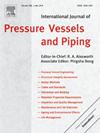Classifying internal and external wall defects in ferromagnetic pipelines utilizing an asymmetric "M-shaped" magnetizer
IF 3
2区 工程技术
Q2 ENGINEERING, MECHANICAL
International Journal of Pressure Vessels and Piping
Pub Date : 2025-05-03
DOI:10.1016/j.ijpvp.2025.105532
引用次数: 0
Abstract
Accurate classification of internal and external defects in pipelines is crucial, as defects of the same size can have different impacts based on their location. This study introduces a method for distinguishing between internal and external defects using magnetic permeability perturbation testing (MPPT), which is known for its high sensitivity to micro defects of ferromagnetic components. This method employs an asymmetrical "M-shaped" magnetizer, using pole shoes of different thicknesses to achieve layered magnetization. By analyzing the differences in MPPT signals to classify defects effectively. A magnetic circuit model and a finite element simulation model with varying pole-shoe thicknesses were established, revealing that varying the pole-shoe thickness can change the magnetization level. An experimental platform was constructed to validate the simulation results. Theoretical and experimental analyses demonstrate that the method is user-friendly, highly efficient in detection, and capable of classifying internal and external defects of various sizes on ferromagnetic components with a thickness of 20 mm. Notably, the method shows resilience against variations in defect size and component thickness. Selecting the optimal combination of pole shoe thicknesses can help improve classification accuracy. This straightforward and practical method holds significant potential for the classification of internal and external defects, providing substantial value in non-destructive testing applications.
利用非对称m型磁化器对铁磁管道内外壁缺陷进行分类
管道内部和外部缺陷的准确分类是至关重要的,因为相同尺寸的缺陷会根据其位置产生不同的影响。本研究介绍了一种利用磁导率微扰测试(MPPT)区分内部缺陷和外部缺陷的方法,该方法对铁磁元件的微缺陷具有很高的灵敏度。该方法采用不对称的“m”形磁化器,使用不同厚度的极靴来实现分层磁化。通过分析MPPT信号的差异,对缺陷进行有效分类。建立了变极靴厚度的磁路模型和有限元仿真模型,揭示了改变极靴厚度可以改变磁化水平。搭建了实验平台对仿真结果进行验证。理论和实验分析表明,该方法具有用户友好、检测效率高的特点,能够对厚度为20mm的铁磁元件的各种尺寸的内部和外部缺陷进行分类。值得注意的是,该方法显示出对缺陷尺寸和部件厚度变化的弹性。选择最佳的极靴厚度组合有助于提高分类精度。这种简单实用的方法对于内部和外部缺陷的分类具有重要的潜力,在非破坏性测试应用中提供了实质性的价值。
本文章由计算机程序翻译,如有差异,请以英文原文为准。
求助全文
约1分钟内获得全文
求助全文
来源期刊
CiteScore
5.30
自引率
13.30%
发文量
208
审稿时长
17 months
期刊介绍:
Pressure vessel engineering technology is of importance in many branches of industry. This journal publishes the latest research results and related information on all its associated aspects, with particular emphasis on the structural integrity assessment, maintenance and life extension of pressurised process engineering plants.
The anticipated coverage of the International Journal of Pressure Vessels and Piping ranges from simple mass-produced pressure vessels to large custom-built vessels and tanks. Pressure vessels technology is a developing field, and contributions on the following topics will therefore be welcome:
• Pressure vessel engineering
• Structural integrity assessment
• Design methods
• Codes and standards
• Fabrication and welding
• Materials properties requirements
• Inspection and quality management
• Maintenance and life extension
• Ageing and environmental effects
• Life management
Of particular importance are papers covering aspects of significant practical application which could lead to major improvements in economy, reliability and useful life. While most accepted papers represent the results of original applied research, critical reviews of topical interest by world-leading experts will also appear from time to time.
International Journal of Pressure Vessels and Piping is indispensable reading for engineering professionals involved in the energy, petrochemicals, process plant, transport, aerospace and related industries; for manufacturers of pressure vessels and ancillary equipment; and for academics pursuing research in these areas.

 求助内容:
求助内容: 应助结果提醒方式:
应助结果提醒方式:


